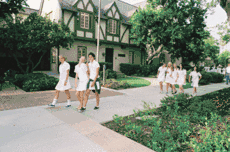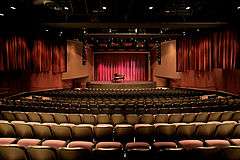Westridge School (Pasadena)
| Westridge School | |
|---|---|
 | |
| Address | |
|
324 Madeline Drive Pasadena, California 91105 United States | |
| Information | |
| Type | Private, Day, College-prep |
| Motto |
Surgere Tentamus (We strive to rise.) |
| Established | 1913 |
| Head of School | Elizabeth J. McGregor |
| Faculty | 82 |
| Grades | 4–12 |
| Gender | Girls |
| Enrollment | 500[1] |
| Student to teacher ratio | 8:1 |
| Athletics | 12 sports[2] |
| Athletics conference | CIF Southern Section Prep League |
| Mascot | Tiger |
| Website | www.westridge.org; www.westridge-alumnae.org |

Westridge School is a private, independent day school for college-bound girls located in Pasadena, California. Elizabeth J. McGregor became the school's 11th head of school on July 1, 2008. Westridge was founded in 1913.
Campus highlights
The Westridge campus provides an idyllic park-like setting in a residential neighborhood. The campus is distinguished not only by its welcoming beauty, but also by an unusually rich architectural heritage. The main building, designed by Marston, VanPelt & Maybury and built in 1923 on the site of the original school, houses classrooms, administrative offices, and one of the school's four technology centers. The Burgess Exhibition Gallery in the main hall features student art exhibits throughout the year.
Herrick Quadrangle, behind the main building, is bordered with both historic and contemporary architecture. Adjoining the main building are the Joan Irvine Smith '36 Academic Research Center and Braun Music Center, which is home to the Howard S. Swan Choral Hall.
The Braun Music Center was designed in 1909 by architect Frederick L. Roehrig, also known for designing the Green Hotel and the Tournament of Roses House in Pasadena, as a private gymnasium and theatre for a family living on Orange Grove Boulevard. In 1958, Westridge parent Henry Dreyfuss added a larger and more functional stage to Braun Music Center.
Three other significant buildings on the Quad were designed by Pasadena architect Whitney R. Smith: the Seeley G. Mudd Science Building, with three fully equipped Upper School laboratories and a computer technology center, the Laurie and Susan Frank Art Studio and the Hoffman Gymnasium. The Richard N. Frank Athletic Field and Ranney Lawn provide recreational spaces for all grades.
In 1997, the school began a building program to enable the campus to better serve the needs of Westridge students and the space demands of an expanded, modern curriculum. Pica & Sullivan Architects designed the Marjorie May Braun '36 Science Building and the Karsh Family Science Garden that contain science classrooms and outdoor study spaces specifically designed for Lower and Middle School students. In April 2000, Westridge dedicated the Anne F. and James F. Rothenberg Humanities Center. The three-building complex also designed by Pica & Sullivan Architects, contains humanities classrooms and faculty offices, Upper School art studios and photography labs, art and photography exhibition space, the school's largest technology lab, and the Herrick Commons dining room.
In 2004, Westridge unified the north and south campuses with the creation of Madeline Court. The following year brought the addition of the Rokus Athletic Complex where Tiger soccer and softball teams host games on new regulation fields. Dance is taught in Brown Studio and athletes take advantage of the Studenmund weight-training room. In 2005, the Fran Norris Scoble Performing Arts Center opened. The world-class facility includes a 600-seat auditorium, the Wagener Black Box Theater and the Seiter Family Amphitheater.
The oldest and most architecturally significant building sits on the southeast corner of the campus. Pitcairn House, built in 1906 by the architectural firm of Greene and Greene, is a classic example of the California Bungalow style and is often pictured in books on the architecture of that period. Pitcairn House is the location of the school's business and development offices. It was previously the location of the art department.
In early spring/late winter, Westridge offers a Summer Opportunities Fair, open to the community, listing summer camps, volunteer programs, and day camps. Options are available for girls and boys, pre-K through 12th grade through local, national, and international programs.[3]
School traditions
At the beginning of each school year, all new students, faculty, and staff are initiated in Westridge’s longstanding tradition of either becoming a Greek or a Roman. If a relation of a student attended the school earlier, the student will be placed in whichever group their relation was in. It is a lighthearted rivalry with fun and games at the beginning of the each year in a sorting ceremony. Points are awarded throughout the year through various activities and a trophy is presented at the end of the school year to whichever side has garnered the most points.
There is an annual Ring Ceremony in April in which the junior class receives their class rings and the Head of School speaks. During this ceremony, each girl's name is read out and she receives her ring from the Head of School and a white rose from the Mistress of the Rings. The Mistress of the Rings is a member of the junior class who found the golden ring in the annual Ring Cake Ceremony that occurs prior to the Ring Ceremony. This ceremony is seen as the junior's passage into being seniors. In the past, the junior would receive her ring from a senior who had been a significant friend or mentor to her. It is unknown why the school changed this most popular part of the tradition.
In November, the school holds a Yam Festival, where parents and students bring yam dishes originating from places all around the globe. This tradition began to help represent the African-American community at Westridge and has become something every student enjoys and looks forward to. The Yam Festival always follows a set of spirit days where the students get to dress up based on the theme of the day.
Right before school gets out for Christmas break, Westridge holds a Holiday Concert in which girls from the lower school, middle school, and upper school Glee Club and orchestra perform holiday music. The fourth graders always have a special cute song to perform; they keep it a secret until the day of the concert.
The day before winter break, seniors write and perform original skits in which they make fun of teachers and other students. At the beginning, Santa Claus comes and each grade decides on two wishes it wants him to grant. One funny wish and one serious wish. Past wishes have ranged from world peace and senior's acceptance to college to the hope that cookie Tuesday could happen everyday.
Westridge also has one day of the year called All School Day. The ASB, associated student body, prepares a day in which the entire school relaxes and just has fun. The ASB prepares activities, food, and a movie. A theme is announced every All School Day. Previous themes have been Disneyridge, All Around the World, British Invasion and Time Warp Westridge. The theme is announced at a special assembly that morning, after a fake theme is announced.
Additionally, the girls participate in Big and Little Sisters where students of all ages are assigned into a "Family." Families meet every few months to participate in activities to bond, like making Christmas cards. This tradition is a way for younger students to have a friendship with older students. Big Sisters are seen as role models for Little Sisters. The families are now assigned based upon girl's Greek/Roman affiliation. They continue each year, and as girls graduate or leave, others join the families. The families traditionally meet once at the beginning of the year, again before holiday break, and once during the spring.
Notable alumnae
- Florence Lowe "Pancho" Barnes '19, early aviator, proprietor of The Happy Bottom Riding Club in Mojave, California and friend of America's best known test pilots
- Julia Child, celebrated chef, author, and television personality
- Harriet Doerr '27, author of the American Book Award winning novel, Stones for Ibarra
- Joan Hotchkis '45, author, playwright, and actress
- Anne Kursinski '76, world champion rider and member of four Olympic Equestrian Teams
- Inger Miller '90, runner, Olympic gold medalist
- Stacey Tappan '91, Leading Soprano opera singer
- Megan McGinnis '96, Broadway actress, singer
- Sophia Bush '00, actress, 82nd Rose Queen for the 111th Tournament of Roses Parade in 2000, Brooke Davis in One Tree Hill.
- Rebecca Rittenhouse '07, Actress Blood & Oil
- Erica Wu '14, table tennis player, 2012 Olympian
Organizations and affiliations
Westridge is a member of the following organizations:
- National Association of Independent Schools
- National Coalition of Girls' Schools
- The College Board
- The National Association for College Admission Counseling
- The National Association of Principals of Schools for Girls
- A Better Chance, Inc.
- The Cum Laude Society
- Council for Spiritual and Ethical Education
- The Independent School Alliance for Minority Affairs.
References
- ↑ K-12 Directory of Schools
- ↑ Athletics
- ↑ Summer Opportunities Fair, Westridge School
External links
Coordinates: 34°07′35″N 118°09′24″W / 34.126526°N 118.156710°W